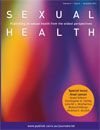
Sexual Health
Volume 9 Number 6 2012
Anal Cancer
SH12109Why a special issue on anal cancer and what is in it?
This editorial describes the contents of this special issue of Sexual Health devoted to anal cancer. The aim of the issue is to provide readers with information to assist them in making decisions about preventing or detecting anal cancer early in men who have sex with men with HIV. It discusses the epidemiology of HPV infection, anal intraepithelial neoplasia, and anal cancer, anal cancer screening and treatment of anal cancer.
SH12070The epidemiology of anal cancer
Anal cancer is increasing in incidence in the developed world. Human papillomavirus (HPV) infection causes 80 to 90% of all cases, making it the second most strongly HPV-related cancer. HPV-16 causes around 90% of HPV positive cases. Incidence is highest among HIV positive homosexual men, in whom it is one of the most common of all cancers. Women with a history of HPV-associated cancer and transplant recipients are also at high risk.
SH12039Geographical clustering of anal cancer incidence in Australia
We investigated the burden of anal squamous cell carcinoma (SCC) in areas with high populations of homosexual men. In postcodes where > 10% of males reported homosexual identity, the average annual age-standardised incidence rates of anal SCC in males was 7.61 per 100 000, over nine times that of the incidence among all men in Australia. These results suggest a need for geographical focussing of anal cancer health care services.
The article stresses the importance of new terminology accepted internationally in relation to the gross anatomy and histology of the anal canal. Particular emphasis of this article is to assist the clinicians and health care providers to more precisely identify the lesions through naked eye observation and without the need of instrumentation. This knowledge may assist in making decisions in regards to the diagnosis, treatment and management of malignant anal canal lesions.
SH12014Anal sex practices in heterosexual and male homosexual populations: a review of population-based data
Anal sex is known to be an important risk factor for anal cancer, yet little population-based research on the practice exists. The data that are available suggest an increasing minority of heterosexuals have ever practised anal intercourse, as have most, but not all homosexual men. The most important finding of the review was the dearth of population-based data, particularly relating to homosexual men.
SH12043The epidemiology and natural history of anal human papillomavirus infection in men who have sex with men
The prevalence of anal HPV infection is very high in MSM, particularly in those who are HIV positive. Factors associated with anal HPV detection include history of receptive anal intercourse, number of male sexual partners and history of anal warts. The significance of the high burden of HPV in this population is unclear, due to limited longitudinal data. A greater understanding of the natural history of anal HPV infection in MSM will greatly inform anal cancer prevention strategies in this population.
SH12021The epidemiology of anal human papillomavirus infection among women and men having sex with women
HPV is a common infection of the anal canal among women and men who have sex with women (MSW), even among individuals who report no receptive anal sex. Factors consistently associated with HPV in the anal canal of women and MSW are number of sexual partners and genital HPV detection. HPV vaccination reduces anal HPV infection among women and is also a promising prevention strategy among MSW.
SH11167Epidemiology, natural history and risk factors for anal intraepithelial neoplasia
Anal intraepithelial neoplasia (AIN) is frequently detected in HIV-seropositive individuals. Factors that increase the risk for AIN include HIV infection, low current or nadir blood CD4+ cell counts, receptive anal intercourse, oncogenic human papillomavirus (HPV) infection, persistent anal HPV infection, multiple HPV type infections and high anal HPV viral load. This review confirms the importance of high-grade AIN in HIV-seropositive individuals and HIV-seronegative men having sex with men.
SH12003Screening for anal neoplasia: anal cytology – sampling, processing and reporting
Anorectal cytology (ARC) is increasingly accepted as a screening tool for squamous intraepithelial lesions in populations at increased risk for anal cancer. As with cervical cancer screening, proper specimen collection and processing are essential for optimal cytological samples. Interval anal cytology for high-risk individuals is a valuable tool for the early detection of human papillomavirus-associated anal squamous epithelial lesions and carcinomas.
SH10140The reporting of anal cytology and histology samples: establishing terminology and criteria
Our understanding of the human papillomavirus related cytomorphology and histopathology of the anal canal is underpinned by our knowledge of human papillomavirus infection in the cervix. In this review we utilise cervical reporting of cytological and histological specimens as a foundation for the development of standardised and evidence-based terminology and criteria for reporting of anal specimens. Standardisation is important because it will increase the value of the data collected as Australian centres develop programs for screening for anal neoplasia.
SH11178Comparison of the performance of anal cytology and cervical cytology as screening tests
Cervical cytology screening has a long history and has successfully reduced the impact of cervical cancer. Anal cytology is a relative newcomer and anal screening is currently offered in only a few centres around the world. While there are many similarities between cervical and anal squamous cell carcinoma, there are also important differences. Because of this, in order to assess the value of anal cytology, well designed anal screening trials are essential.
SH11139Prevalence and predictors of high-grade anal intraepithelial neoplasia in a community-based sample of homosexual men
A cross-sectional study of 332 community recruited homosexual men found anal cytological abnormalities in 24.3% of HIV-negative and 57.5% of HIV-positive men. Histologically confirmed HGAIN was detected in 21. HGAIN was prevalent in homosexual men across all age groups and was more than twice as common in HIV-positive men compared with HIV-negative men. The presence of high-risk anal HPV was highly predictive of HGAIN.
Anal cancer is similar to cervical cancer and is potentially preventable using methods modelled after those used to prevent cervical cancer. To visualize the anal cancer precursor high-grade anal intraepithelial neoplasia, high-resolution anoscopy (HRA) is performed using a colposcope with acetic acid and Lugol’s solution. Visible lesions are biopsied and may be treated in an effort to reduce the risk of progression to cancer. The technique of HRA, its uses and challenges in prevention of anal cancer are described in this article.
SH11157Treatment options for anal intraepithelial neoplasia and evidence for their effectiveness
There is a growing range of treatment options for anal intraepithelial neoplasia. These include surgical removal and topical agents. In the shorter term, destructive treatment methods, possibly including trichloroacetic acid, are more effective than self applied topical treatments. In HIV-positive patients treatments may have to be ongoing for several years, when both surgical and topical approaches have yielded sustained clearance from high grade anal intraepithelial neoplasiain more than 60% of patients.
SH12010Squamous cell carcinoma of the anal canal: a review of the aetiology, presentation, staging, prognosis and methods available for treatment
Anal cancer is an uncommon malignancy. The increasing incidence of this disease reflects a rise in the transmission of the human papillomavirus. Abdominoperineal resection has been supplanted by chemoradiation as the first-line therapy. Surgeons continue to play a role in the multidisciplinary management of patients with anal cancer for diagnosis and post-treatment surveillance. Human papillomavirus vaccines present a potential for the eradication of the disease.
SH12017The cost-effectiveness of screening for anal cancer in men who have sex with men: a systematic review
Anal cancer is a relatively rare neoplasm, with an incidence that does not warrant general screening. Screening in men who have sex with men (MSM) may be appropriate, given their elevated risk of anal cancer. A systematic review of the literature was conducted to examine existing cost-effectiveness analyses of anal cancer screening in MSM. Results show considerable variability, primarily driven by data paucity; by summarising key uncertainties in existing models, this review can inform the design and conduct of future studies.
SH11169Psychosocial aspects of anal cancer screening: a review and recommendations
Cancer screening programs have the potential to decrease psychosocial wellbeing. This review investigates the evidence that anal cancer screening has an impact on psychosocial functioning and outlines considerations for supporting participants. The review suggested that screening has no significant effect on general mental health but may increase cancer-specific worry. Having worse anal or HIV symptoms, being younger, higher baseline distress or worse histology results were predictive of greater worry. The findings suggest the need to increase education campaigns, particularly targeting those with HIV infection and men who have sex with men. There is a need to develop a consensus on measuring the psychosocial impact of screening and stepped care approaches for responding to any resulting distress.
SH12116Time for a strategic research response to anal cancer
The articles in this special edition of Sexual Health clearly demonstrate that anal cancer is increasing in incidence and, in some populations, it has become an urgent public health priority. In this summary paper, the authors review the data presented in this issue and elsewhere on the magnitude of the issue, the means of prevention and treatment, and suggest a way forward.



